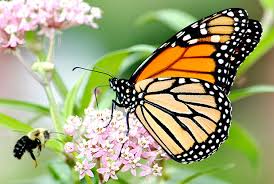13
Sep
Monarch Butterflies at Risk of Extinction; Pesticides, Habitat Loss to Blame
(Beyond Pesticides, September 13, 2017) According to a study published in the journal Biological Conservation, Monarch butterfly populations  from western North America have declined far more dramatically than was previously known and face a greater risk of extinction – 86 percent in the next 50 years. The researchers do not know the exact cause but identify habitat loss and widespread pesticide use as likely culprits.
from western North America have declined far more dramatically than was previously known and face a greater risk of extinction – 86 percent in the next 50 years. The researchers do not know the exact cause but identify habitat loss and widespread pesticide use as likely culprits.
Migratory monarchs in the west could disappear in the next few decades if steps are not taken to recover the population, the study’s lead author, Cheryl Schultz, PhD, an associate professor at Washington State University Vancouver states. “Western monarchs are faring worse than their eastern counterparts. In the 1980s, 10 million monarchs spent the winter in coastal California. Today there are barely 300,000,” she said.
Western monarchs (Danaus plexippus) have a spectacular migration. They overwinter in forested groves along coastal California, then lay their eggs on milkweed and drink nectar from flowers in the spring in Arizona, California, Nevada, Oregon, Washington, Idaho and Utah. They then return to their coastal overwintering sites in the fall. Eastern monarch, whose numbers are also in decline, travel instead across the border into Mexico to wait out the winter. The researchers from Washington State University, working with communities along the coast of California, pooled data on butterfly numbers from across the state to create a single estimate of the western monarch’s numbers. They then predicted the monarch population’s risk of extinction over the next several decades. The study concludes that current trends indicate an extinction risk of 72% in 20 years and 86% in 50 years.
The study, “Citizen science monitoring demonstrates dramatic declines of monarch butterflies in western North America,” funded by the U.S. Fish and Wildlife Service (FWS), notes the exact causes of the decline in western monarchs are not yet clear, but the loss and modification of its habitat and pesticide use across the West, where monarchs breed, are likely culprits. Climate change and threats to coastal California overwintering sites likely also play a role.
Dr. Schultz adds, “This study doesn’t just show that there are fewer monarchs now than 35 years ago. It also tells us that, if things stay the same, western monarchs probably won’t be around as we know them in another 35 years.”
FWS is set to determine whether to protect monarch butterflies under the Endangered Species Act. An agreement was made with Center for Food Safety and the Center for Biological Diversity in July 2016 which requires the agency to decide by June 2019 whether the butterflies will receive federal protection. This agreement came in response to a lawsuit earlier that year to force the agency to set a legally binding deadline for a decision on a 2014 petition calling for protection of the species. Many see FWS’ consideration of federal protection for monarchs as a positive step toward improving habitat and raising awareness about the decline of the butterfly, as well as the plight of other pollinator populations
Monarch butterflies are one of many important pollinator species that have experienced drastic declines in recent years. Monarch butterflies lay their eggs on milkweed that grows wild, and reduced sources of milkweed pose a threat to monarch populations. The use of genetically engineered (GE) crops (Roundup-ready crops) allows the use of Monsanto’s glyphosate in cropland, which is an important factor in the decline of the monarch. Glyphosate eradicates milkweed and the dramatic surge in Roundup use and “Roundup Ready” crops has virtually wiped out milkweed plants in Midwestern corn and soybean fields. It is estimated that in the past 20 years these butterflies have lost more than 165 million acres of habitat.
Along with threats from glyphosate use and habitat loss, the use of neonicotinoid pesticides has also been linked to monarch declines. A 2016 study found that the increasing use of neonicotinoid (neonic) insecticides is correlated with a steep decline in butterfly health and reproductive success. This study looked at 67 species of butterfly in Northern California and found a correlation between butterfly population decline and increasing neonic applications, which also appeared to be more severe for smaller-bodied species. According to the researchers, the results suggest that neonics could influence non-target insect populations when applied nearby. Pesticides like neonicotinoids also harm other non-target pollinators like honey bees and other bee species. Studies show an association with decreased learning, foraging and navigational ability, as well as increased vulnerability to pathogens and parasites, in bees.
Critical to the survival of monarchs, other pollinators, and organisms essential to ecological balance is the large-scale adoption of organic farming practices. Beyond Pesticides supports organic agriculture as effecting good land stewardship and a reduction in hazardous chemical exposures for workers on the farm. The pesticide reform movement, citing pesticide problems associated with chemical agriculture, from groundwater contamination and runoff to drift, views organic as the solution to a serious public health and environmental threat.
There are several steps that may be taken to attract beneficial insects like monarchs and protect backyard habitats. Like any other living organisms, pollinators need food, water, and shelter in order to thrive. Planting milkweed in your backyard is a surefire way to help monarch populations. For more information, see Managing Landscapes with Pollinators in Mind and Hedgerows for Biodiversity: Habitat is needed to protect pollinators, other beneficial organisms, and healthy ecosystems. More information is available in the BEE Protective Habitat Guide and Do-It-Yourself Biodiversity.
All unattributed positions and opinions in this piece are those of Beyond Pesticides.
Source: Phys.org, Reuters.com










